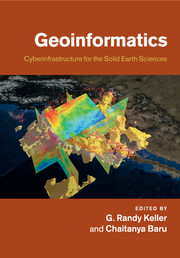Book contents
- Frontmatter
- Contents
- List of contributors
- Preface
- Introduction
- Part I Case studies from other disciplines
- 3 Semantic cyberinfrastructure: The Virtual Solar-Terrestrial Observatory
- 4 Cyberinfrastructures for life sciences and biomedicine
- Part II Modeling software and community codes
- Part III Visualization and data representation
- Part IV Knowledge management and data integration
- Part V Web services and scientific workflows
- Part VI Emerging international and other efforts
- Index
- Plate section
- References
3 - Semantic cyberinfrastructure: The Virtual Solar-Terrestrial Observatory
from Part I - Case studies from other disciplines
Published online by Cambridge University Press: 25 October 2011
- Frontmatter
- Contents
- List of contributors
- Preface
- Introduction
- Part I Case studies from other disciplines
- 3 Semantic cyberinfrastructure: The Virtual Solar-Terrestrial Observatory
- 4 Cyberinfrastructures for life sciences and biomedicine
- Part II Modeling software and community codes
- Part III Visualization and data representation
- Part IV Knowledge management and data integration
- Part V Web services and scientific workflows
- Part VI Emerging international and other efforts
- Index
- Plate section
- References
Summary
Introduction
The utilization of now fairly well established information technology (IT) to provide access to science data and information is becoming more routine. The present foundational IT includes hardware services utilizing computers, disks, and networks along with software systems such as databases, web servers, portals, and so on. At the same time, scientific data are being collected or generated and maintained in digital form (repositories) in high volumes by many diverse research projects and groups. The need for access to, and interoperability between, these repositories is also growing, as research groups need to access their own increasingly diverse data collections. As investigations begin to include results from many different sources, researchers also need to access and utilize other research groups' data repositories from within a single discipline or, more interestingly, among multiple disciplines. Also, it is not simply trained scientists who are interested in accessing scientific data; nonspecialists are becoming interested in looking at trends in scientific data as well. Two notable examples are in the areas of natural hazards and environmental impact assessments. While the promise of true virtual interconnected heterogeneous distributed international data repositories is being realized in a number of areas there is still much work to be done. To address ultimate goals such as to provide support for both specialist and broader nonspecialist usage, including lay people from a rich set of science and information product, new approaches are being devised. One such approach is that of Virtual Observatories (VOs: Dalton, 2007).
Information
- Type
- Chapter
- Information
- GeoinformaticsCyberinfrastructure for the Solid Earth Sciences, pp. 21 - 36Publisher: Cambridge University PressPrint publication year: 2011
